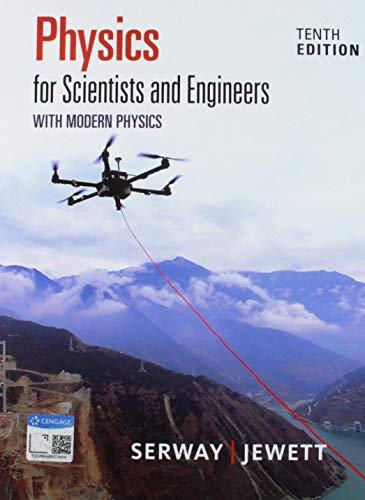
Concept explainers
(a)
The expression of the integer
(a)
Answer to Problem 49CP
The expression of the integer
Explanation of Solution
Given info: The index reflection for film is
The condition of the destructive interference for minimum intensity is,
Here,
Rearrange the equation (1) to find the
The condition of constructive interference for the maximum intensity of fringes is,
Rearrange the equation (2) to find the
Since,
The wavelength of the maximum intensity is greater than the wavelength of the minimum intensity.
Substitute
Hence, the above equation exists for
Substitute
Substitute
Conclusion:
Therefore, the expression of the integer
(b)
The best thickness of the film.
(b)
Answer to Problem 49CP
The best thickness of the film is
Explanation of Solution
Given info: The index reflection for film is
Thus, the expression of the integer order of fringe
Substitute
The condition of the destructive interference for minimum intensity is,
Substitute
The condition of constructive interference for the maximum intensity of fringes is,
Substitute
Substitute
The average of the thickness at minimum intensity and thickness of the maximum intensity is,
The average of the thickness at minimum intensity and thickness of the maximum intensity represents the best thickness of film.
Conclusion:
Therefore, the best thickness of the film is
Want to see more full solutions like this?
Chapter 36 Solutions
Bundle: Physics For Scientists And Engineers With Modern Physics, 10th + Webassign Printed Access Card For Serway/jewett's Physics For Scientists And Engineers, 10th, Multi-term
- An object is placed 24.1 cm to the left of a diverging lens (f = -6.51 cm). A concave mirror (f= 14.8 cm) is placed 30.2 cm to the right of the lens to form an image of the first image formed by the lens. Find the final image distance, measured relative to the mirror. (b) Is the final image real or virtual? (c) Is the final image upright or inverted with respect to the original object?arrow_forwardConcept Simulation 26.4 provides the option of exploring the ray diagram that applies to this problem. The distance between an object and its image formed by a diverging lens is 5.90 cm. The focal length of the lens is -2.60 cm. Find (a) the image distance and (b) the object distance.arrow_forwardPls help ASAParrow_forward
 Principles of Physics: A Calculus-Based TextPhysicsISBN:9781133104261Author:Raymond A. Serway, John W. JewettPublisher:Cengage Learning
Principles of Physics: A Calculus-Based TextPhysicsISBN:9781133104261Author:Raymond A. Serway, John W. JewettPublisher:Cengage Learning Physics for Scientists and Engineers: Foundations...PhysicsISBN:9781133939146Author:Katz, Debora M.Publisher:Cengage Learning
Physics for Scientists and Engineers: Foundations...PhysicsISBN:9781133939146Author:Katz, Debora M.Publisher:Cengage Learning University Physics Volume 3PhysicsISBN:9781938168185Author:William Moebs, Jeff SannyPublisher:OpenStax
University Physics Volume 3PhysicsISBN:9781938168185Author:William Moebs, Jeff SannyPublisher:OpenStax An Introduction to Physical SciencePhysicsISBN:9781305079137Author:James Shipman, Jerry D. Wilson, Charles A. Higgins, Omar TorresPublisher:Cengage Learning
An Introduction to Physical SciencePhysicsISBN:9781305079137Author:James Shipman, Jerry D. Wilson, Charles A. Higgins, Omar TorresPublisher:Cengage Learning Physics for Scientists and Engineers, Technology ...PhysicsISBN:9781305116399Author:Raymond A. Serway, John W. JewettPublisher:Cengage Learning
Physics for Scientists and Engineers, Technology ...PhysicsISBN:9781305116399Author:Raymond A. Serway, John W. JewettPublisher:Cengage Learning Physics for Scientists and EngineersPhysicsISBN:9781337553278Author:Raymond A. Serway, John W. JewettPublisher:Cengage Learning
Physics for Scientists and EngineersPhysicsISBN:9781337553278Author:Raymond A. Serway, John W. JewettPublisher:Cengage Learning





